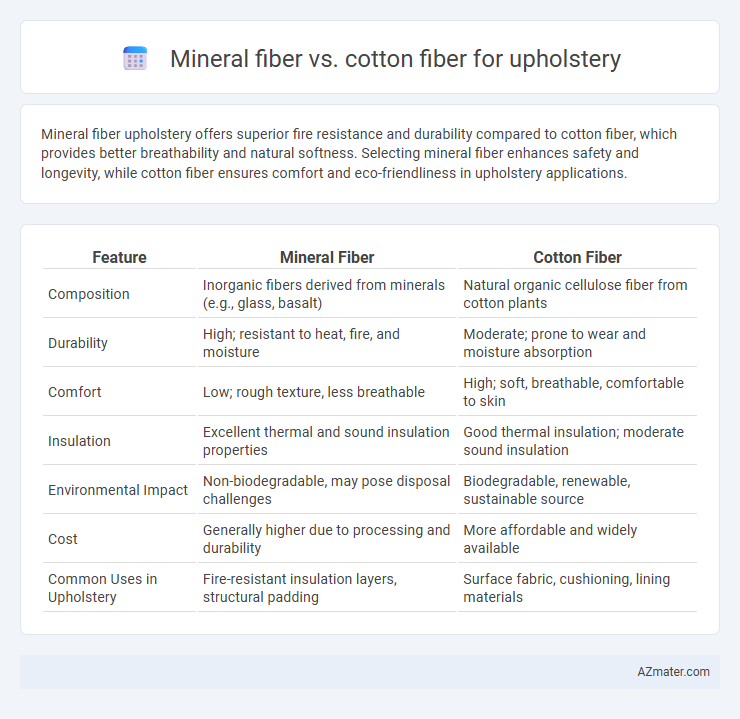Mineral fiber upholstery offers superior fire resistance and durability compared to cotton fiber, which provides better breathability and natural softness. Selecting mineral fiber enhances safety and longevity, while cotton fiber ensures comfort and eco-friendliness in upholstery applications.
Table of Comparison
| Feature | Mineral Fiber | Cotton Fiber |
|---|---|---|
| Composition | Inorganic fibers derived from minerals (e.g., glass, basalt) | Natural organic cellulose fiber from cotton plants |
| Durability | High; resistant to heat, fire, and moisture | Moderate; prone to wear and moisture absorption |
| Comfort | Low; rough texture, less breathable | High; soft, breathable, comfortable to skin |
| Insulation | Excellent thermal and sound insulation properties | Good thermal insulation; moderate sound insulation |
| Environmental Impact | Non-biodegradable, may pose disposal challenges | Biodegradable, renewable, sustainable source |
| Cost | Generally higher due to processing and durability | More affordable and widely available |
| Common Uses in Upholstery | Fire-resistant insulation layers, structural padding | Surface fabric, cushioning, lining materials |
Introduction to Upholstery Fiber Choices
Mineral fiber and cotton fiber are two distinct materials used in upholstery, each offering unique benefits. Mineral fibers, such as glass or rock wool, provide excellent durability, fire resistance, and insulation properties, making them ideal for heavy-use furniture and safety-focused applications. Cotton fibers, on the other hand, deliver natural breathability, softness, and eco-friendliness, preferred for comfortable seating and sustainable upholstery solutions.
Overview of Mineral Fiber Materials
Mineral fiber materials, commonly used in upholstery, consist primarily of fiberglass or ceramic fibers known for their high thermal resistance and durability. These fibers offer superior flame retardant properties compared to traditional cotton fibers, making them ideal for applications requiring enhanced fire safety. Their non-combustible nature and resistance to degradation provide long-lasting support and protection in upholstered furniture.
Characteristics of Cotton Fiber
Cotton fiber, derived from the cotton plant's seed hairs, is highly valued for its natural softness, breathability, and moisture absorption properties, making it comfortable for upholstery use. It exhibits excellent dye retention and resistance to high temperatures, but it can be prone to wrinkling and shrinking if not properly treated. Compared to mineral fiber, cotton offers superior tactile comfort and biodegradability, although it may lack the flame resistance and durability of synthetic or mineral-based fibers.
Durability: Mineral Fiber vs Cotton
Mineral fiber upholstery offers superior durability compared to cotton fiber, with enhanced resistance to wear, moisture, and fire. Cotton fiber tends to weaken and degrade faster under frequent use and exposure to sunlight, resulting in a shorter lifespan. Mineral fiber's robust structure maintains fabric integrity, making it ideal for high-traffic furniture applications.
Comfort and Texture Comparison
Mineral fiber upholstery offers superior durability but tends to be less soft and breathable compared to cotton fiber, which provides a plush and comfortable texture ideal for extended seating. Cotton fiber's natural moisture-wicking properties enhance comfort by maintaining temperature balance, while mineral fiber can feel rougher and less flexible, impacting overall coziness. Choosing cotton fiber upholstery maximizes softness and breathability, making it preferred for comfort-focused furniture applications.
Fire Resistance and Safety Features
Mineral fiber upholstery offers superior fire resistance due to its non-combustible properties and ability to withstand high temperatures without melting or emitting toxic fumes, making it a safer choice in fire-prone environments. Cotton fiber, while breathable and comfortable, is inherently flammable and typically requires chemical treatments to improve fire retardancy, which may degrade over time. Choosing mineral fiber for upholstery enhances safety standards in residential and commercial spaces by minimizing fire hazards and ensuring compliance with strict fire codes.
Environmental Impact and Sustainability
Mineral fiber upholstery, such as fiberglass, often involves energy-intensive manufacturing processes with limited recyclability, contributing to higher environmental footprints compared to cotton fiber. Cotton fiber, especially organic cotton, is biodegradable and renewable, offering a more sustainable choice with lower greenhouse gas emissions and reduced chemical use when cultivated responsibly. However, cotton production can demand significant water resources, so selecting sustainably farmed cotton enhances overall environmental benefits in upholstery applications.
Cost Analysis and Value for Money
Mineral fiber insulation typically costs more upfront than cotton fiber but offers superior durability and resistance to moisture and fire, enhancing long-term value for upholstery projects. Cotton fiber, while less expensive and environmentally friendly, may require more frequent replacement due to lower durability and susceptibility to mold. Evaluating cost analysis involves considering initial expenses against lifespan and maintenance, with mineral fiber delivering better return on investment for high-traffic or commercial upholstery applications.
Best Use Cases for Each Fiber
Mineral fiber, such as fiberglass, offers excellent fire resistance and durability, making it ideal for upholstery in commercial or high-traffic environments where safety and longevity are paramount. Cotton fiber provides superior breathability and softness, perfect for residential upholstery requiring comfort and natural materials. Choosing mineral fiber suits spaces demanding rigorous standards, whereas cotton fiber excels in cozy, low-traffic settings prioritizing comfort and sustainability.
Final Recommendation: Selecting the Right Upholstery Fiber
Mineral fiber offers superior fire resistance and durability, making it ideal for high-traffic or commercial upholstery applications, while cotton fiber provides softness, breathability, and natural comfort suited for residential furniture. Selecting the right upholstery fiber depends on balancing factors like maintenance requirements, allergen sensitivity, and longevity expectations. For long-term investment and safety, mineral fiber is recommended; for eco-friendly and cozy upholstery, cotton fiber remains a preferred choice.

Infographic: Mineral fiber vs Cotton fiber for Upholstery
 azmater.com
azmater.com